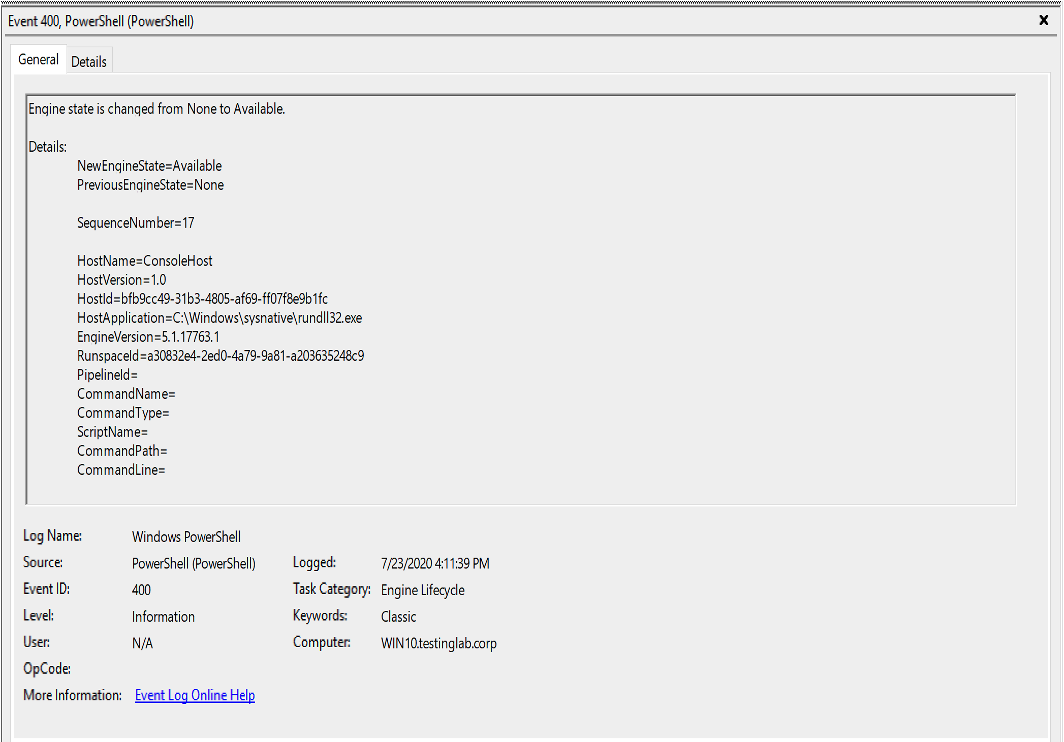In recent months, CrowdStrike® Services has observed a continued increase in the use of Cobalt Strike by eCrime and nation-state adversaries to conduct their operations following the initial access to victims’ environments.The
Both of these commands have a similar aim: to allow the user to execute PowerShell scripts on the target system. The Artifacts generated before
Figure 1 shows an example of the EID 400 event log generated by the execution of the Observations of
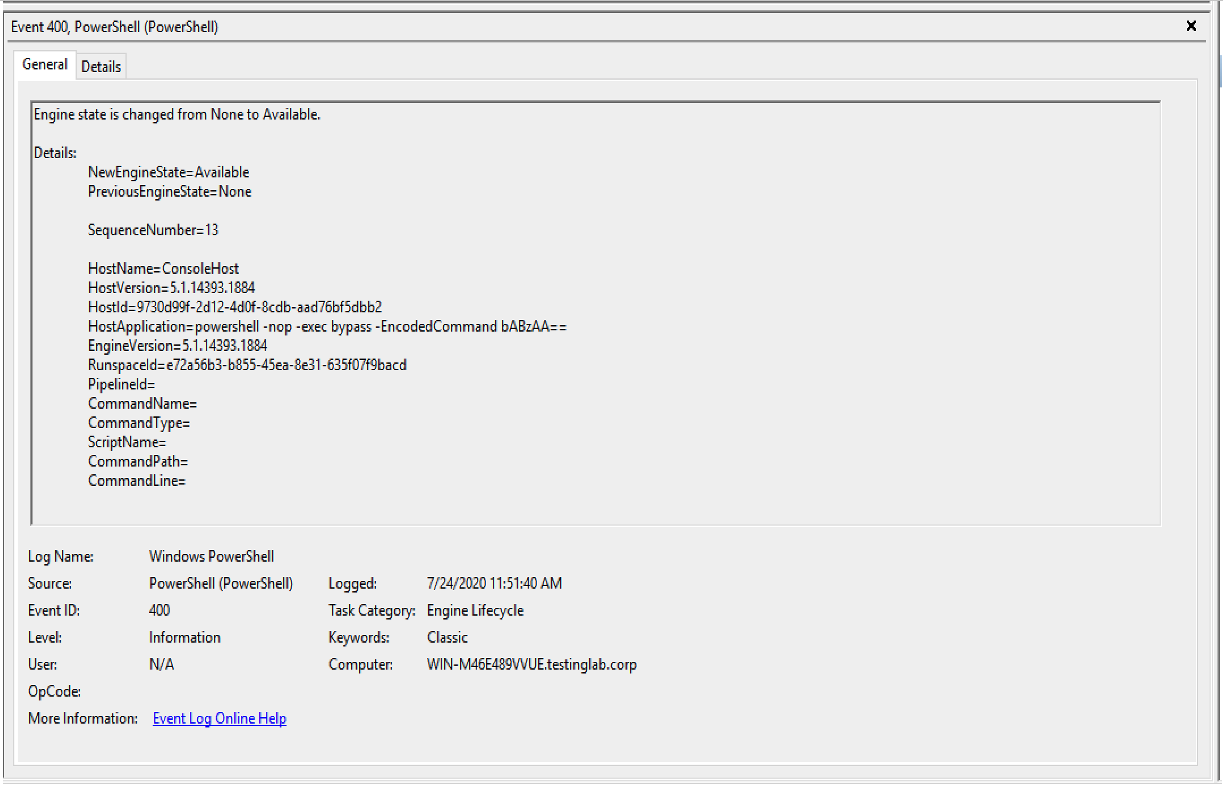 Figure 1. Artifact generated by the
An example of the observed artifact as shown in Figure 1:
Figure 1. Artifact generated by the
An example of the observed artifact as shown in Figure 1:
Artifacts generated after
Figure 2, shows an example of the EID 400 generated on the compromised system after execution of the powershell command after a script was imported with powershell-import. The base64 encoded command decodes to IEX (New-Object Net.Webclient).DownloadString('http://127.0.0.1:22426/'); ls . The IEX (New-Object Net.Webclient).DownloadString('http://127.0.0.1:22426/') component of the base64 encoded command is how Cobalt Strike manages imported PowerShell scripts within a Beacon session. The rest of the command, after the DownloadString component, is the PowerShell command run by the adversary.Observations from
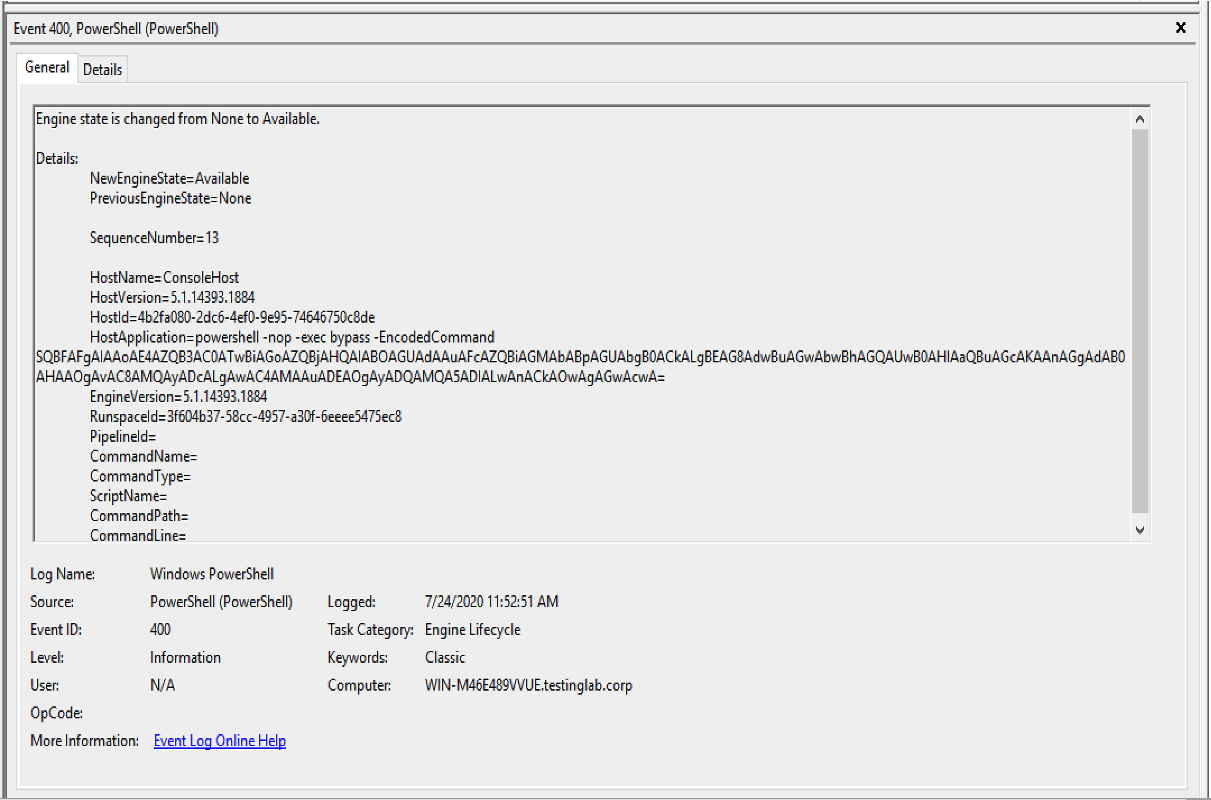 Figure 2. Artifact generated by the
An example of the observed artifact as shown in Figure 2:
Figure 2. Artifact generated by the
An example of the observed artifact as shown in Figure 2:
The
The Observations of
The
The Observations of
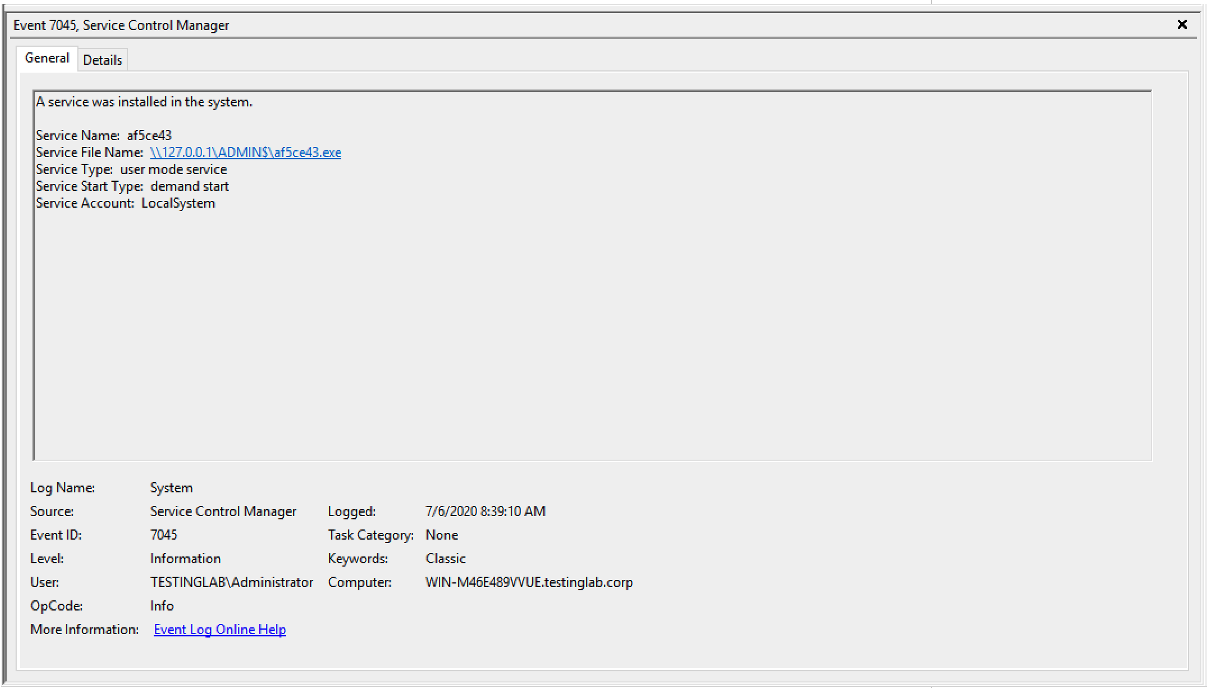 Figure 4. Artifact generated by the
An example of the observed artifact as shown in Figure 4:
By default, events generated by the
Figure 4. Artifact generated by the
An example of the observed artifact as shown in Figure 4:
By default, events generated by the Observations of
 Figure 5. Artifact generated by the
Figure 5. Artifact generated by the
The
The Observations of
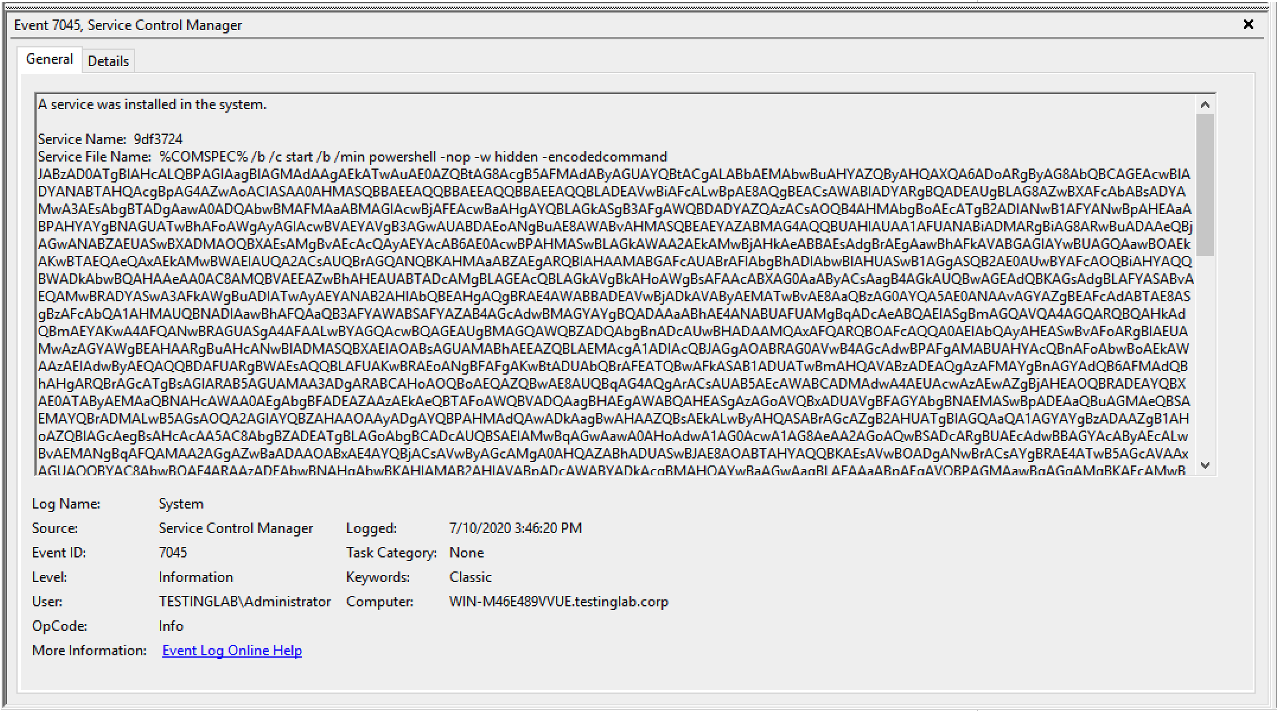 Figure 6. Artifact generated by the
An example of the observed artifact as shown in Figure 6:
Figure 6. Artifact generated by the
An example of the observed artifact as shown in Figure 6:
The
The Observations of
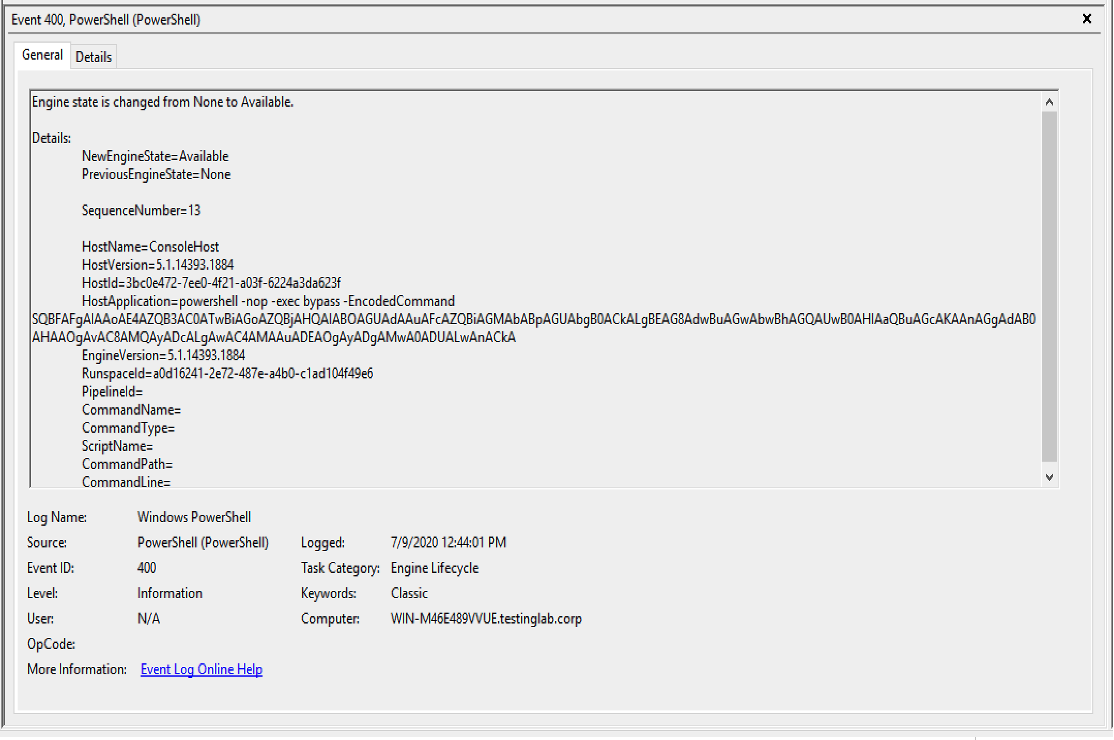 Figure 7. Artifact generated by the
An example of the observed artifact as shown in Figure 7:
If a WinRM listener is not present on the remote system when the
Figure 7. Artifact generated by the
An example of the observed artifact as shown in Figure 7:
If a WinRM listener is not present on the remote system when the Observations of an event created by
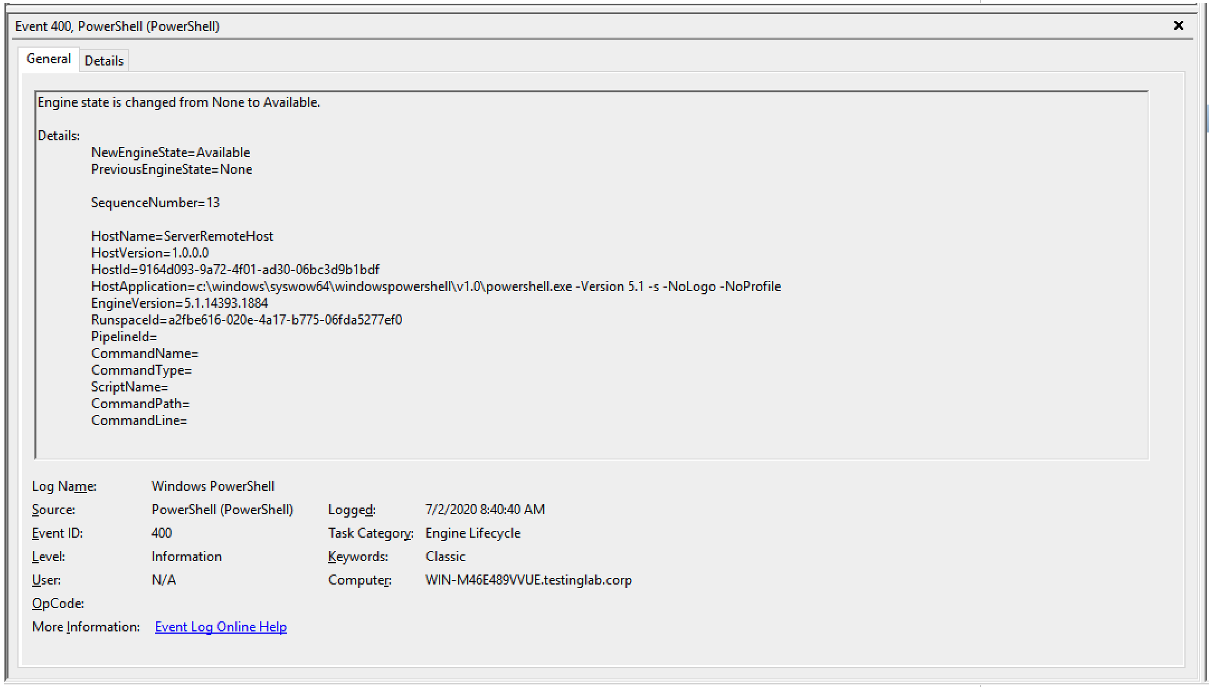 Figure 8. Artifact generated by the
Figure 8. Artifact generated by the
The
The Observations of
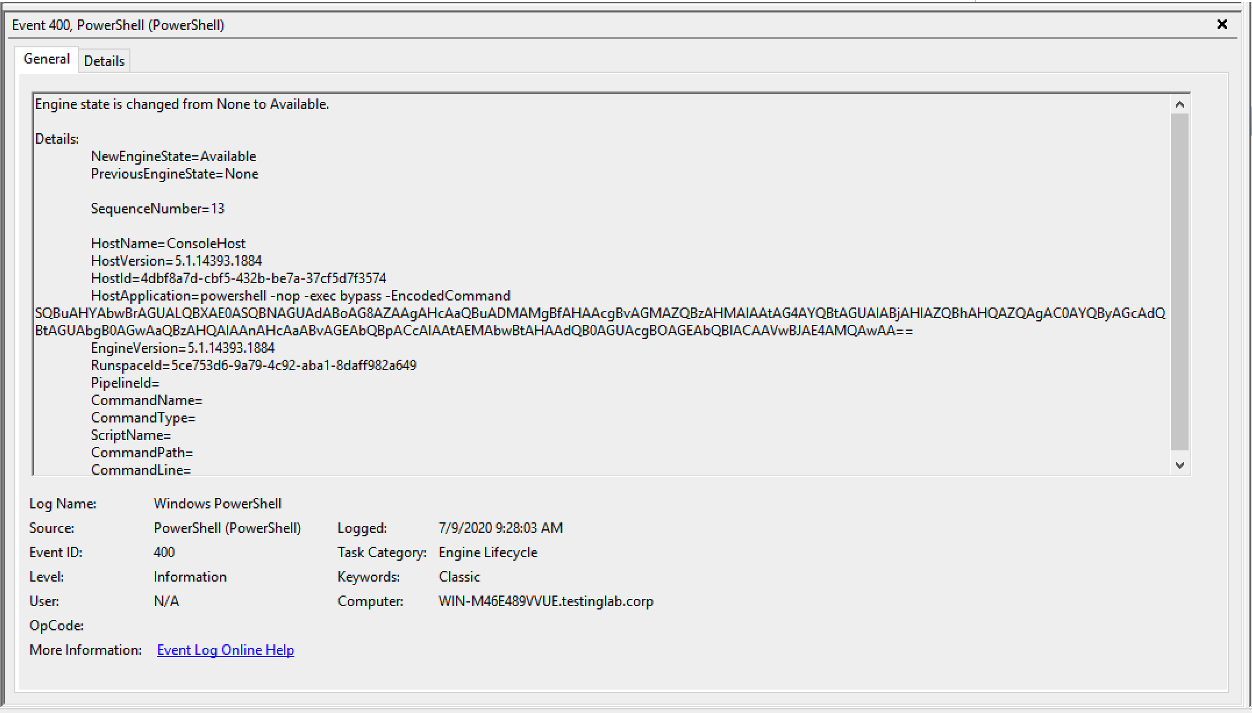 Figure 9. Artifact generated by the
Figure 9. Artifact generated by the
The
The Observations of
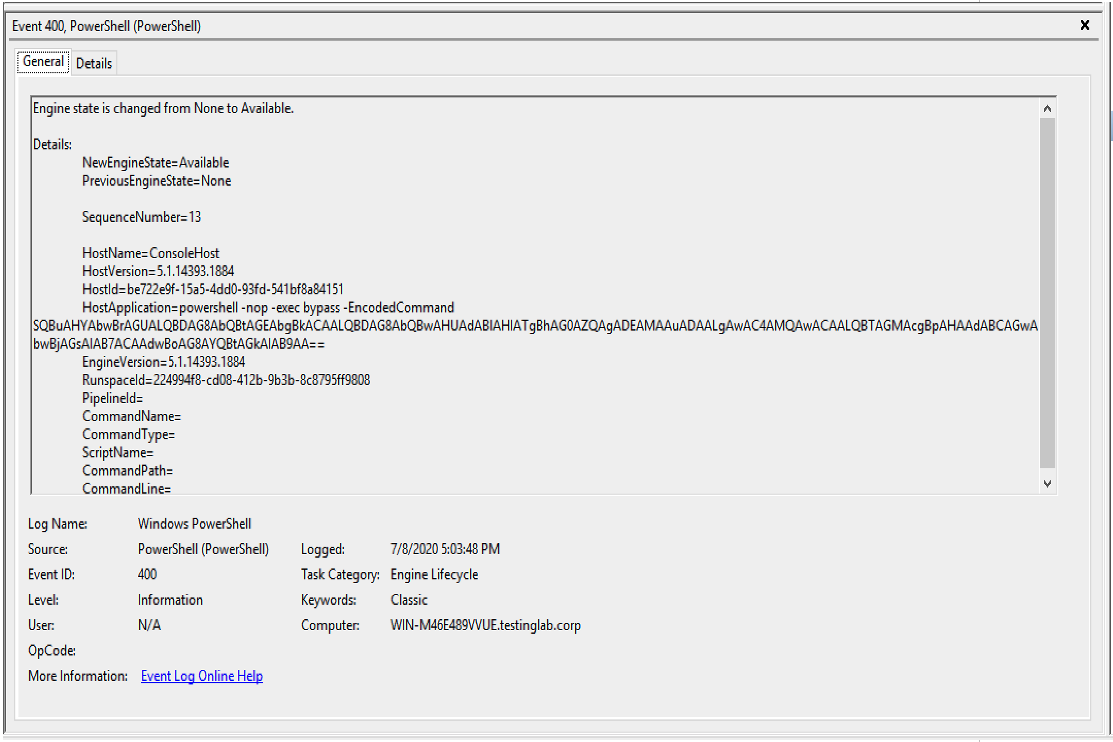 Figure 10. Artifact generated by the
An example of the observed artifact as shown in Figure 10:
Figure 10. Artifact generated by the
An example of the observed artifact as shown in Figure 10:
Cobalt Strike is a commercially available post-exploitation framework developed for adversary simulations and red team operations and features an easy-to-use interface. Although the vendor uses processes and technology measures in an effort to limit distribution of Cobalt Strike to security professionals, adversaries have also been observed using Cobalt Strike. In the CrowdStrike 2020 Threat Hunting Report, The Falcon OverWatch team reported Cobalt Strike as the #2 most common penetration testing tool observed in the first half of 2020. A common feature used by adversaries is the Cobalt Strike framework client agent, known as Beacon. The Beacon client agent is executed in the memory space of a compromised system, typically leaving minimal on-disk footprints. This blog discusses CrowdStrike’s research and testing of Cobalt Strike’s Beacon in an isolated Active Directory domain to identify host-based indicators generated from the use of this tool. This blog also enumerates and provides an explanation of host-based artifacts generated as a result of executing specific built-in Beacon commands. The artifacts can be used to create detection and prevention signatures in Windows environments, aiding in the positive identification of remnants of Beacon execution.
Beacon Behavior Summary
Adversaries often execute a variety of Beacon commands once they establish a foothold within an environment. Beacon commands can be used to spawn other Beacons on additional systems accessible to the initial Beacon, effectively furthering persistence in the target environment. Beacons can also be leveraged for remote access and execution.
- The execution of the commands highlighted in this blog will generate a variety of Windows security events depending on the context of the command: The Beacon commands
jump psexecandjump psexec_pshwill generate an EID 7045 (Service Installation) fromSystem.evtx. - The additional commands will generate an EID 400 event log
(PowerShell Engine Startup) from WindowsPowerShell.evtx.
HostApplication field begin with a command prefix. With the default configuration that command prefix is powershell -nop -exec -bypass -EncodedCommand. Although this prefix is configurable, CrowdStrike has observed adversaries leverage the default configuration in multiple incident response (IR) engagements.
Beacon Commands
As part of our research, CrowdStrike Services evaluated the following Beacon commands, which are encountered frequently in incident response engagements:- powershell and powershell-import
- powerpick
- jump psexec
- jump psexec_psh
- jump winrm
- remote-exec wmi
- remote-exec powershell
The powershell and powershell-import Commands
Both of these commands have a similar aim: to allow the user to execute PowerShell scripts on the target system. The powershell Beacon command executes commands written in PowerShell within the Cobalt Strike framework. When a red teamer or an adversary executes a command within a Beacon session, the operating system will generate an EID 400 event log (PowerShell Engine Startup) on the system that the command is executed on. The powershell-import Beacon command imports a PowerShell script into the Beacon session. In several WastedLocker ransomware attacks, CrowdStrike Services<1> observed evidence of the network discovery tool PowerView imported by adversaries shortly after establishing a Beacon on a compromised system. The file system artifacts that are generated will vary depending on whether the powershell command is executed before or after the powershell-import command.
Artifacts generated before powershell-import
Figure 1 shows an example of the EID 400 event log generated by the execution of the powershellcommand before a script has been imported with
powershell-import. The base64 encoded command decodes to ls, the command that was executed via the powershell command.
Observations of powershell before powershell-import:
- The
HostApplicationfield is set topowershell -nop -exec -bypass -EncodedCommand <base64-encoded-command> - The Base64 encoded command decodes to the
<command>executed
 Figure 1. Artifact generated by the
Figure 1. Artifact generated by the powershell command before powershell-import is executed (click image to enlarge)HostApplication=powershell -nop -exec Bypass -EncodedCommand bABzAA==
Decoded Base64 Command: lsArtifacts generated after powershell-import
Figure 2, shows an example of the EID 400 generated on the compromised system after execution of the powershell command after a script was imported with powershell-import. The base64 encoded command decodes to IEX (New-Object Net.Webclient).DownloadString('http://127.0.0.1:22426/'); ls . The IEX (New-Object Net.Webclient).DownloadString('http://127.0.0.1:22426/') component of the base64 encoded command is how Cobalt Strike manages imported PowerShell scripts within a Beacon session. The rest of the command, after the DownloadString component, is the PowerShell command run by the adversary.
Observations from powershell after powershell-import:
- The
HostApplicationfield is set topowershell -nop -exec -bypass -EncodedCommand <base64-encoded-command> - The base64 encoded command decodes to IEX
(New-Object Net.Webclient).DownloadString('http://127.0.0.1:<ephemeral-port-number>/'); <command>
 Figure 2. Artifact generated by the
Figure 2. Artifact generated by the powershell command after powershell-import is executed (click image to enlarge)HostApplication=powershell -nop -exec Bypass -EncodedCommand SQBFAFgAIAAoAE4AZQB3AC0ATwBiAGoAZQBjAHQAIABOAGUAdAAuAFcAZQBiAGMAbABpAGUAbgB0ACkALgBEAG8AdwBuAGwAbwBhAGQAUwB0AHIAaQBuAGcAKAAnAGgAdAB0AHAAOgAvAC8AMQAyADcALgAwAC4AMAAuADEAOgAyADQAMQA5ADIALwAnACkAOwAgAGwAcwA=Decoded Base64 Command: IEX (New-Object Net.Webclient).DownloadString('http://127.0.0.1:24192/'); ls
The powerpick Command
The powerpick Beacon command executes unmanaged PowerShell on a compromised system. It provides a way to execute a PowerShell command without invoking powershell.exe. When a red teamer or adversary executes the powerpick command through a Beacon session, the filesystem will generate an EID 400 event log (PowerShell Engine Startup) on the compromised system.
CrowdStrike observed that the EID 400 event log generated by executing the powerpick command will contain a mismatch between the version number in the HostVersion and EngineVersion event log fields. The event generated will also have the path to the rundll32.exe executable in the HostApplication field, as it is the default program that a Beacon will use to create a new process.
Observations of powerpick:
HostNamefield is set toConsoleHostHostApplicationfield is set to the file path ofrundll32.exe- The
HostVersionandEngineVersionfields are set to different values
HostName=ConsoleHost
HostApplication=C:\windows\sysnative\rundll32.exe
HostVersion=1.0
EngineVersion=5.1.17763.1
The jump psexec
Command
The jump psexec Beacon command establishes an additional Beacon on a remote system. When an adversary executes the jump psexec command through a Beacon session, the filesystem will generate an EID 7045 event log (Service Installation) on the remote system.
Observations of jump psexec:
- The Service Name field is set to
<7-alphanumeric-characters> - The Service File Name field is set to
\\127.0.0.1\ADMIN$\<7-alphanumeric-characters>.exe
 Figure 4. Artifact generated by the
Figure 4. Artifact generated by the jump psexec Beacon command when executed on the remote system prior to version 4.1 of Cobalt Strike (click image to enlarge)Service Name: af5ce43
Service File Name: \\127.0.0.1\ADMIN$\af5ce43.exe
jump psexec Beacon command using versions of Cobalt Strike prior to version 4.1 will have the 127.0.0.1 localhost string in the value of the “Service File Name,” an example of this is \\127.0.0.1\ADMIN$\7f5747a.exe. Events generated with version 4.1+ of Cobalt Strike will contain the destination computer’s IP address in the “Service File Name” by default and an example of this is \\10.0.0.16\ADMIN$\9a845c4.exe. In that example 10.0.0.16 is the IP address assigned to the target system.
Observations of jump psexec after version 4.1 of Cobalt Strike:
- The Service Name field is set to
<7-alphanumeric-characters> - The Service File Name field is set to
\\<System-IPAddress>\ADMIN$\<7-alphanumeric-characters>.exe
 Figure 5. Artifact generated by the
Figure 5. Artifact generated by the jump psexec Beacon command when executed on the remote system created by version 4.1+ of Cobalt Strike (click image to enlarge)The jump psexec_psh Command
The jump psexec_psh commandestablishes an additional Beacon on a remote system via the Windows Service Control Manager. The
jump_psexec command creates and starts a service that executes a base64 encoded PowerShell Beacon stager, which generates an EID 7045 event log (Service Installation) on the remote system.
The EID 7045 event log created by the jump psexec_psh command has a seven-character alphanumeric value for the “Service Name” field of the created event. The “Service File Name” field starts with the default Cobalt Strike prefix for PowerShell services %COMSPEC% /b /c start /b /min powershell -nop -w hidden -encodedcommand.
Observations of jump psexec_psh:
- The Service Name field is set to
<7-alphanumeric-characters> - The Service File Name field is set to
%COMSPEC% /b /c start /b /min powershell -nop -w hidden -encodedcommand <base64-encoded-command> - The base64 encoded command decodes to a PowerShell stager for a Cobalt Strike Beacon
 Figure 6. Artifact generated by the
Figure 6. Artifact generated by the jump psexec_psh Beacon command when executed on the remote system (click image to enlarge)Service Name: 9df3724
Service File Name: %COMSPEC% /b /c start /b /min powershell -nop -w hidden -encodedcommand JABzA<Redacted>
The jump winrm Command
The jump winrm Beacon command establishes a Beacon on a remote system utilizing the Windows Remote Management (WinRM) interface (native on all Windows devices). When the jump winrm Beacon command is executed by an adversary through a Beacon session, the filesystem will generate an EID 400 event log (PowerShell Engine Startup) on the compromised system. The event created will contain the Cobalt Strike PowerShell command prefix in the HostApplication field. The generated event is not affected by the usage of any of the PowerShell-related Beacon commands.
Observations of jump winrm on the compromised system:
- The
HostApplicationfield is set topowershell -nop -exec -bypass -EncodedCommand <base64-encoded-command> - The base64 encoded command decodes to
IEX (New-Object Net.Webclient).DownloadString(‘http://127.0.0.1:<ephemeral-port-number>/’)
 Figure 7. Artifact generated by the
Figure 7. Artifact generated by the jump winrm Beacon command when executed, on the compromised system (click image to enlarge)HostApplication=powershell -nop -exec bypass -EncodedCommand SQBFAFgAIAAoAE4AZQB3AC0ATwBiAGoAZQBjAHQAIABOAGUAdAAuAFcAZQBiAGMAbABpAGUAbgB0ACkALgBEAG8AdwBuAGwAbwBhAGQAUwB0AHIAaQBuAGcAKAAnAGgAdAB0AHAAOgAvAC8AMQAyADcALgAwAC4AMAAuADEAOgAyADgAMwA0ADUALwAnACkADecoded Base64 Command: IEX (New-Object Net.Webclient).DownloadString('http://127.0.0.1:28345/')
jump winrm command is executed, Cobalt Strike will create an EID 400 event log on the remote system, as shown in Figure 7.
Observations of an event created by jump winrm on the remote system:
- The
HostApplicationfield is set to<path-to-PS-executable> -Version <PS-Version> -s -NoLogo -NoProfile
 Figure 8. Artifact generated by the
Figure 8. Artifact generated by the jump winrm Beacon command when executed on the remote system (click image to enlarge)An example of the observed artifact as shown in Figure 8:
HostApplication=c:\windows\syswow64\windowspowershell\v1.0\powershell.exe -Version 5.1 -s -NoLogo -NoProfile
The remote-exec wmi Command
The remote-exec wmi Beacon command executes a command on a remote system via WMI. When the remote-exec wmi command is executed, the filesystem will generate an EID 400 event log (PowerShell Engine Startup) on the compromised system with the standard Cobalt Strike PowerShell command prefix in the HostApplication field.
Observations of remote-exec wmi:
- The
HostApplicationfield is set topowershell -nop -exec Bypass -EncodedCommand <base64-encoded-command> - The base64 encoded command decodes to
Invoke-WMIMethod win32_process -name create -argumentlist '<command>' -ComputerName <target>
 Figure 9. Artifact generated by the
Figure 9. Artifact generated by the remote-exec wmi Beacon command when executed on the compromised system (click image to enlarge)An example of the observed artifact as shown in Figure 9:
HostApplication=powershell -nop -exec Bypass -EncodedCommand SQBuAHYAbwBrAGUALQBXAE0ASQBNAGUAdABoAG8AZAAgAHcAaQBuADMAMgBfAHAAcgBvAGMAZQBzAHMAIAAtAG4AYQBtAGUAIABjAHIAZQBhAHQAZQAgAC0AYQByAGcAdQBtAGUAbgB0AGwAaQBzAHQAIAAnAHcAaABvAGEAbQBpACcAIAAtAEMAbwBtAHAAdQB0AGUAcgBOAGEAbQBlACAAVwBJAE4AMQAwAADecoded Base64 Command: Invoke-WMIMethod win32_process -name create -argumentlist 'whoami' -ComputerName WIN10
The remote-exec powershell Command
The remote-exec powershell Beacon command executes a command on a remote system via PowerShell remoting from a compromised system. When the remote-exec powershell command is executed, the filesystem will generate an EID 400 event log (PowerShell Engine Startup) on the compromised system. The event created will contain the standard Cobalt Strike PowerShell command prefix in the HostApplication field.
Observations of remote-exec powershell:
- The
HostApplicationfield is set topowershell -nop -exec Bypass -EncodedCommand <base64-encoded-command> - The Base64 encoded command decodes to
Invoke-Command -ComputerName <target> -ScriptBlock { <command> }
 Figure 10. Artifact generated by the
Figure 10. Artifact generated by the remote-exec powershell Beacon command when executed on the compromised system (click image to enlarge)HostApplication=powershell -nop -exec Bypass -EncodedCommand SQBuAHYAbwBrAGUALQBDAG8AbQBtAGEAbgBkACAALQBDAG8AbQBwAHUAdABlAHIATgBhAG0AZQAgADEAMAAuADAALgAwAC4AMQAwACAALQBTAGMAcgBpAHAAdABCAGwAbwBjAGsAIAB7ACAAdwBoAG8AYQBtAGkAIAB9AADecoded Base64 Command: Invoke-Command -ComputerName 10.0.0.10 -ScriptBlock { whoami }
Conclusions
Although Cobalt Strike provides the operator a degree of freedom to configure some of the previously mentioned commands, those features are not always leveraged by adversaries. Due to the high prevalence of Cobalt Strike in contemporary intrusions, CrowdStrike recommends collecting EID 400 (PowerShell Engine Startup) and EID 7045 event logs (Service Installation) for monitoring and alerting in a centralized security information and event management (SIEM) platform.CrowdStrike also recommends upgrading to the most recent version of PowerShell and disabling previous versions, as PowerShell is backward compatible. While these additional security measures do not provide full visibility into Cobalt Strike activity, they can aid in its detection. <1> CrowdStrike has previously reported on adversaries that use Cobalt Strike, such as COBALT SPIDER.
Additional Resources
- Learn more about the CrowdStrike Services team and how it can help your organization improve your cybersecurity readiness.
- Read about the powerful CrowdStrike Falcon® platform by visiting the webpage.
- Test CrowdStrike next-gen AV for yourself. Start your free trial of Falcon Prevent™ today.






![Helping Non-Security Stakeholders Understand ATT&CK in 10 Minutes or Less [VIDEO]](https://assets.crowdstrike.com/is/image/crowdstrikeinc/video-ATTCK2-1?wid=530&hei=349&fmt=png-alpha&qlt=95,0&resMode=sharp2&op_usm=3.0,0.3,2,0)
![Qatar’s Commercial Bank Chooses CrowdStrike Falcon®: A Partnership Based on Trust [VIDEO]](https://assets.crowdstrike.com/is/image/crowdstrikeinc/Edward-Gonam-Qatar-Blog2-1?wid=530&hei=349&fmt=png-alpha&qlt=95,0&resMode=sharp2&op_usm=3.0,0.3,2,0)















































